Arts & Culture
Get Your Fill of Lechon at the Cebu Lechon Festival
Now on its third run, Cebu’s best lechon-makers gather at the Cebu Lechon Festival.
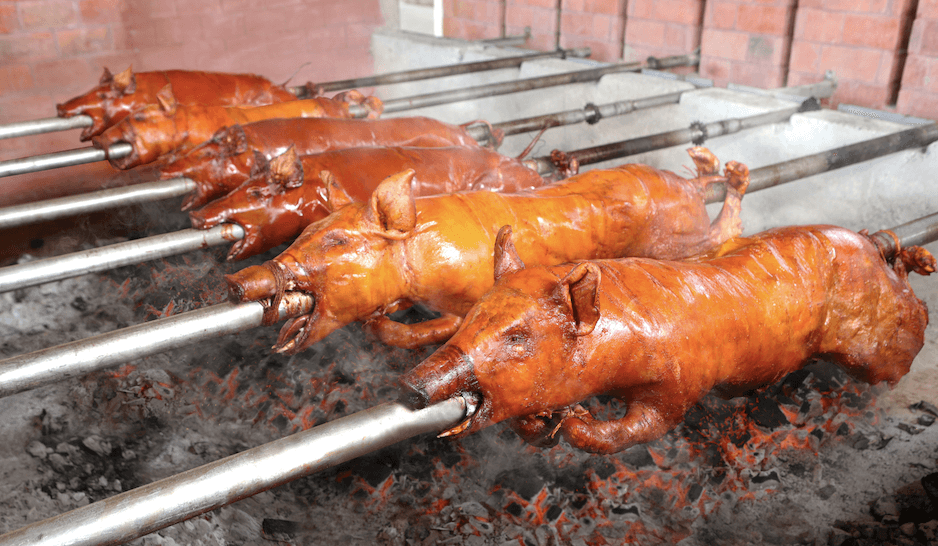
In any Filipino festival or celebration, nothing quite whets the appetite and brings excitement to the palate than seeing the gloriousness of a roasted ‘lechon’ laid beautifully on the buffet table.
While the Philippines is oozing with all sorts of varieties of this now world-famous dish, all delicious in their own way, ask any food-loving Filipino where the best lechon comes from and the response will almost likely be unanimous – Cebu.
There is no denying that the Cebu Lechon is hands-down the best and the most delicious there is, and that no trip to the Queen City of the South will be complete without taking a bite of its famous crunchy golden skin, and juicy, tender and flavorsome meat.
But there is more to lechon than meets the eyes and the palate. This beloved dish is a culinary masterpiece itself that requires long hours in the roasting pit and skills to achieve that perfect balance of meat and fat, and overall flavor.
The world-famous Cebu lechon, along with the rich history, artistry and skills that go into preparing this beloved dish, is the highlight of this year’s Cebu Lechon Festival, spearheaded by The Mactan Newtown, in partnership with the City Government of Lapu-Lapu and the Department of Tourism Region 7 Office.
Now on its third year, the annual gastronomic and cultural celebration promises an authentic Cebuano fiesta experience with its mouthwatering array of lechon varieties from lechon-makers coming from different parts of Cebu province and a vibrant host of cultural spectacles and performances starting today until August 12.
“We want to capitalize on the popularity of the Cebu lechon to bring awareness to small-scale and less commercialized lechon businesses. Apart from providing these businesses with the needed platform to showcase their products and help them grow, our goal is to drive tourism in this part of Cebu and eventually create more employment and livelihood opportunities for the locals,” says Graham Coates, Head of Megaworld Lifestyle Malls.
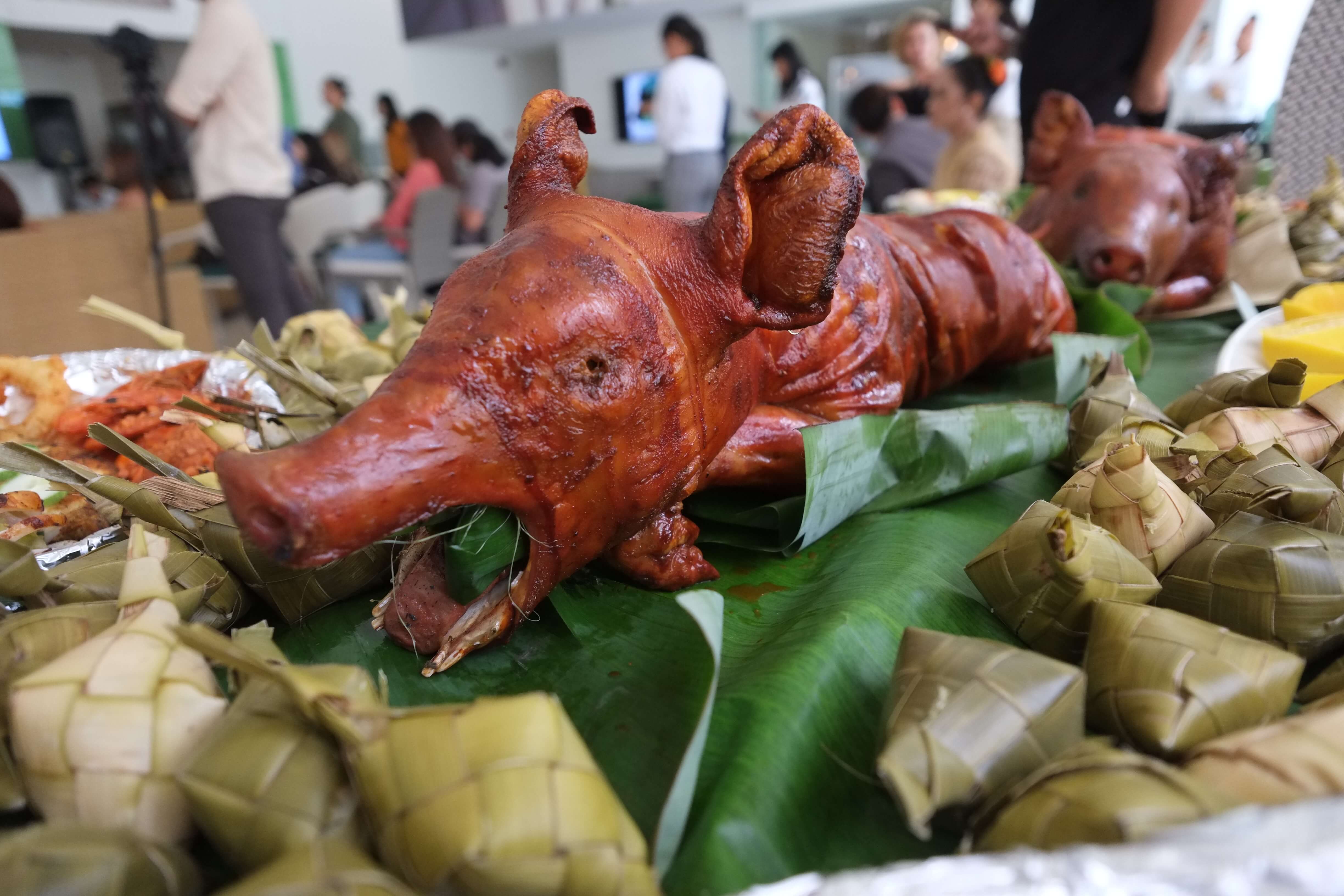
The finest Cebu lechons in one location
The Cebu Lechon Festival gathers some of the best lechon-makers in Cebu Island at the 500-seater Mactan Alfresco inside The Mactan Newtown township, giving guests the rare chance to sample and savor mouthwatering varieties of the Cebu lechon along with a delicious array of lechon-themed dishes and lechon pairings all in one place.
Some of the locally homegrown lechon brands participating in this year’s festival include House of Lechon, Ayers Lechon, Pelyns Lechon, Augustus Lechon, Golden Cowrie Lechon Belly, Yobob Lechon, and Jojo and Mikays Lechon.
During the festival, the lechon will be sold between P400 to P600 per kilo from participating lechon-makers.
Festival-goers can also immerse themselves through the entire lechon preparation process at Mactan Alfresco’s very own Lechon Pit. Here, they can witness lechon-makers perfect their craft and see firsthand how a lechon is made right before their very eyes—from seasoning to roasting at the coal pit, to portioning and serving on their own plates.
For an even more unique and immersive dining experience, guests can devour their lechon and chosen lechon dishes and pairings inside the comforts of colorful and iconic Philippine jeepneys stationed within the Mactan Alfresco complex.
“This will be a very festive Filipino celebration of the renowned Cebu Lechon. We will have ‘fiesta sa nayon’ games, barrio fiesta dancers and drumbeaters, fire dancers and even belly dancers to entertain visitors and guests of the festival,” adds Coates.
An authentic Cebuano fiesta
Festival-goers can enjoy an immersive cultural experience with a variety of Cebuano and lechon-flavored activities highlighted by the Lechon Exhibit on August 9, which will feature delicious varieties of Cebu lechon from the province’s best lechon-makers.
Highlighting the celebrations is a colorful grand street performance to be participated in by various cultural dance groups, street dancers, marching bands, and the Sinulog Festival Queen.
A traditional boodle fight featuring participants from the annual Ironman 70.3 Philippines and lechon sellers will also be held on August 9, following the street performance, while live musical performances and a grand fireworks display that will illuminate the skies of The Mactan Newtown will cap off the festivities.
The highlights of the celebration will happen on August 9 to 11. The weekend will be highlighted by the Lechon Fest Grand Party, where guests can feast on different varieties of Cebu Lechon, grilled meat, and seafood while being treated to cultural dance numbers and live performances from buskers, local bands and stand-up comedians.
Guests, meanwhile, can also learn more about the Cebu Lechon and have their photos taken at the different installations on display at the venue including a lechon-themed Philippine jeepney during the entire festival’s run, or bring home souvenir items from Mactan Alfresco’s Souvenir Shop.
Arts & Culture
Visayas Art Fair Year 5: Infinite Perspectives, Unbound Creativity
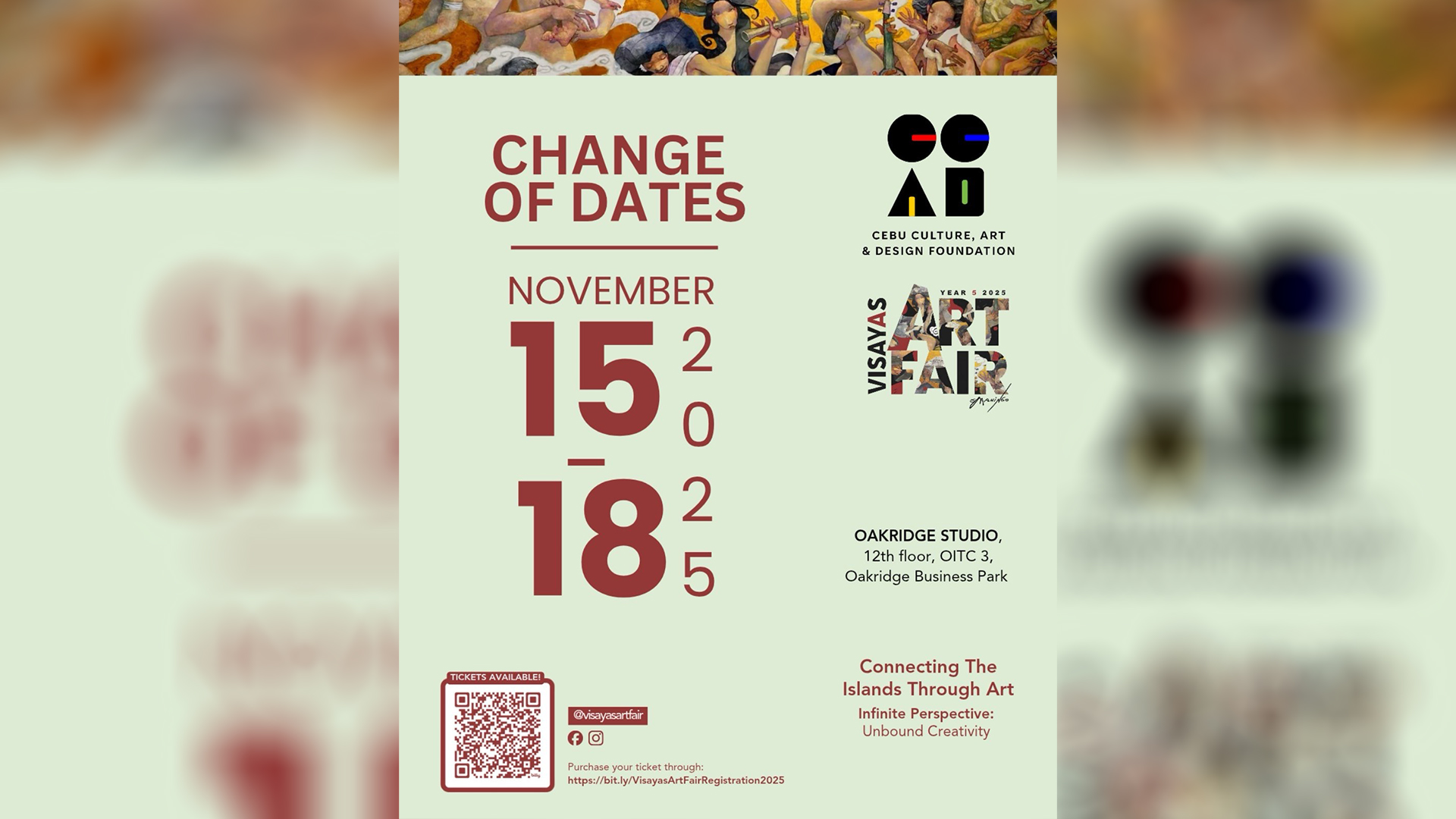
by Jing Ramos
This year’s Visayas Art Fair marks its 5th anniversary, celebrating the theme “Infinite Perspectives: Unbound Creativity.” The fair continues its mission of bridging creativity, culture, and community in the country. This milestone edition strengthens its partnership with the National Commission for Culture and the Arts and expands collaborations with regional art organizations and collectives—reinforcing its role as a unifying platform for Philippine art.
VAF5 features the works of Gil Francis Maningo, honoring the mastery of his gold leaf technique on opulent portraits of the Visayan muse Carmela, reflecting spiritual awareness.
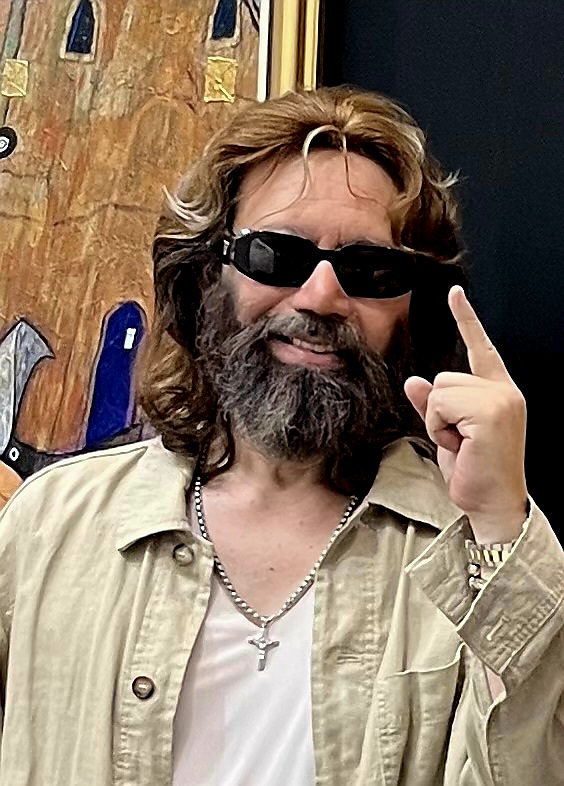
Gil Francis Maningo is celebrated for his gold leaf technique.
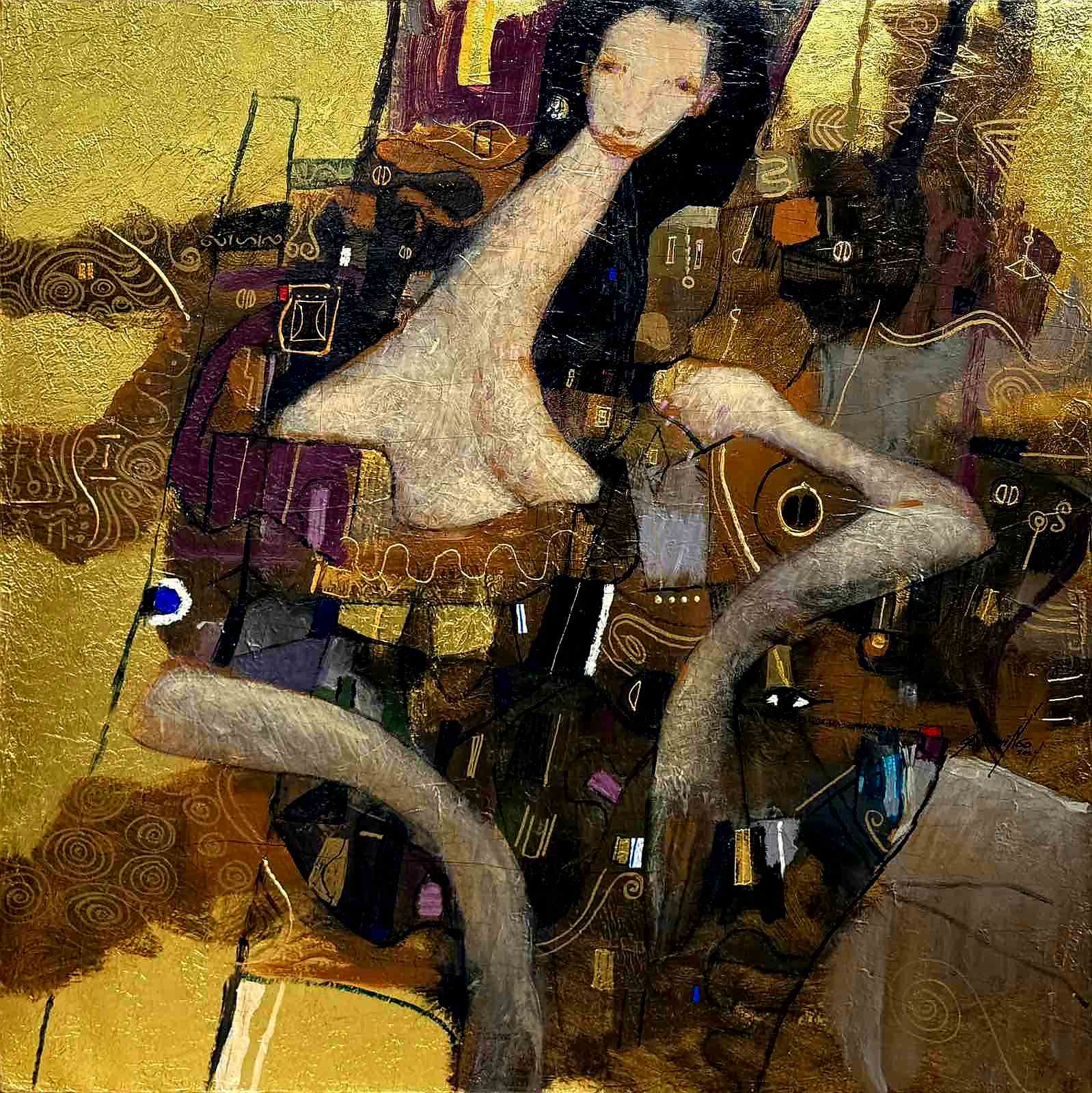
Gil Francis Maningo’s recurring theme of his Visayan muse “Carmela”.
Another featured artist is Danny Rayos del Sol, whose religious iconography of Marian-inspired portraits offers a profound meditation on the sacred and the sublime. This collaboration between two visual artists sparks a dialogue on the Visayan spirit of creativity and resilience. Titled “Pasinaya,” this dual showcase explores gold leaf as a medium of light and transcendence.
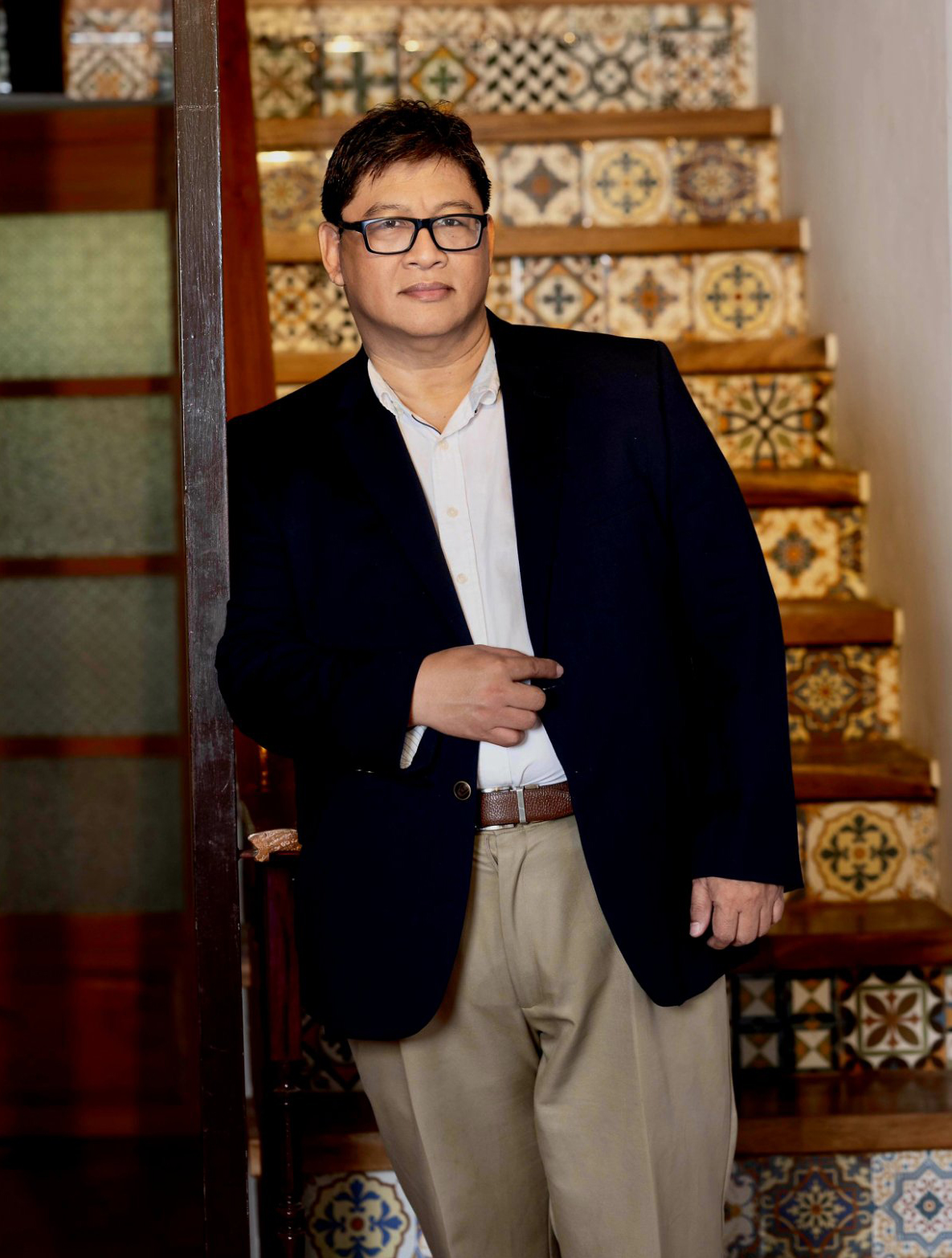
Artist Danny Reyes del Sol
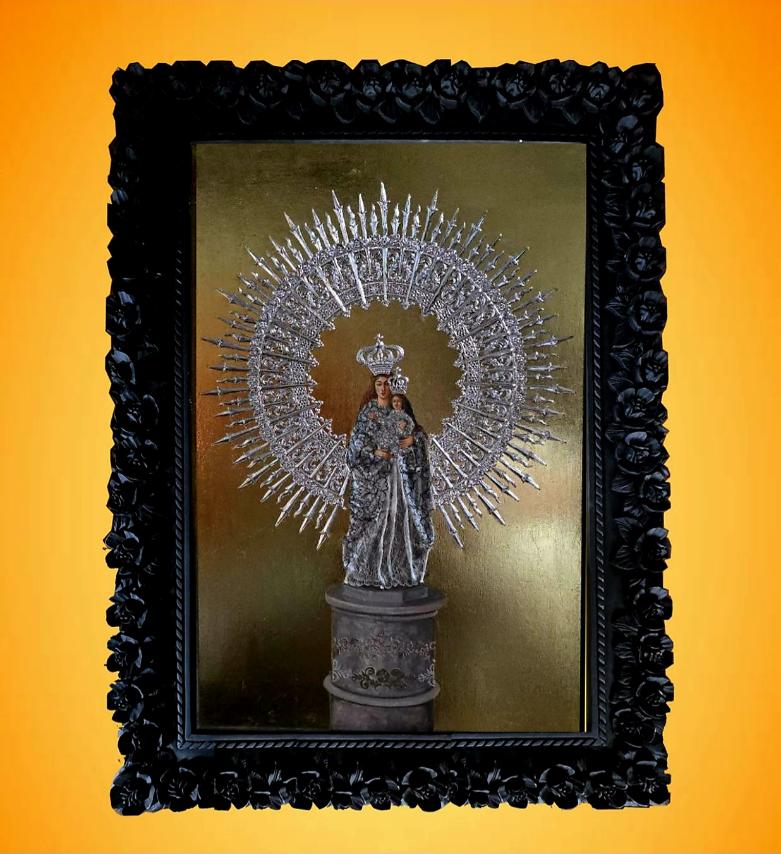
Danny Reyes del Sol’s religious iconography.
Now in its fifth year, the Visayas Art Fair has influenced a community of artists, gallerists, brokers, collectors, museum curators, and art critics—constructing a narrative that shapes how we approach and understand the artist and his work. This combination of factors, destined for popular consumption, illustrates the ways in which art and current culture have found common ground in a milieu enriched by the promise of increased revenue and the growing value of artworks.
Laurie Boquiren, Chairman of the Visayas Art Fair, elaborates on the theme, expressing a vision that celebrates the boundless imagination of unique artistic voices:
“Infinite Perspectives speaks of the countless ways artists see, interpret, and transform the world around them—reminding us that creativity knows no single point of view. Unbound Creativity embodies freedom from convention and controlled expression, allowing every artist to explore and experiment without borders.”
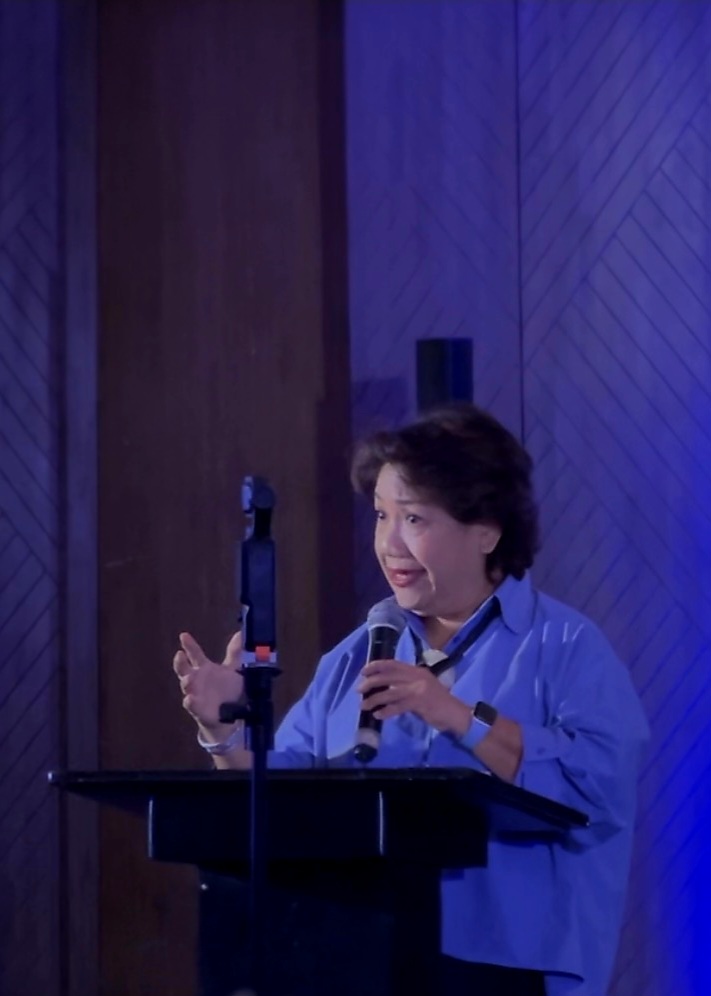
Laurie Boquiren, Chairman of the Visayas Art Fair has tirelessly championed the creative arts for the past five years.
Arts & Culture
Kultura. Kapital. Kasalukuyan: Art that Speaks of Today
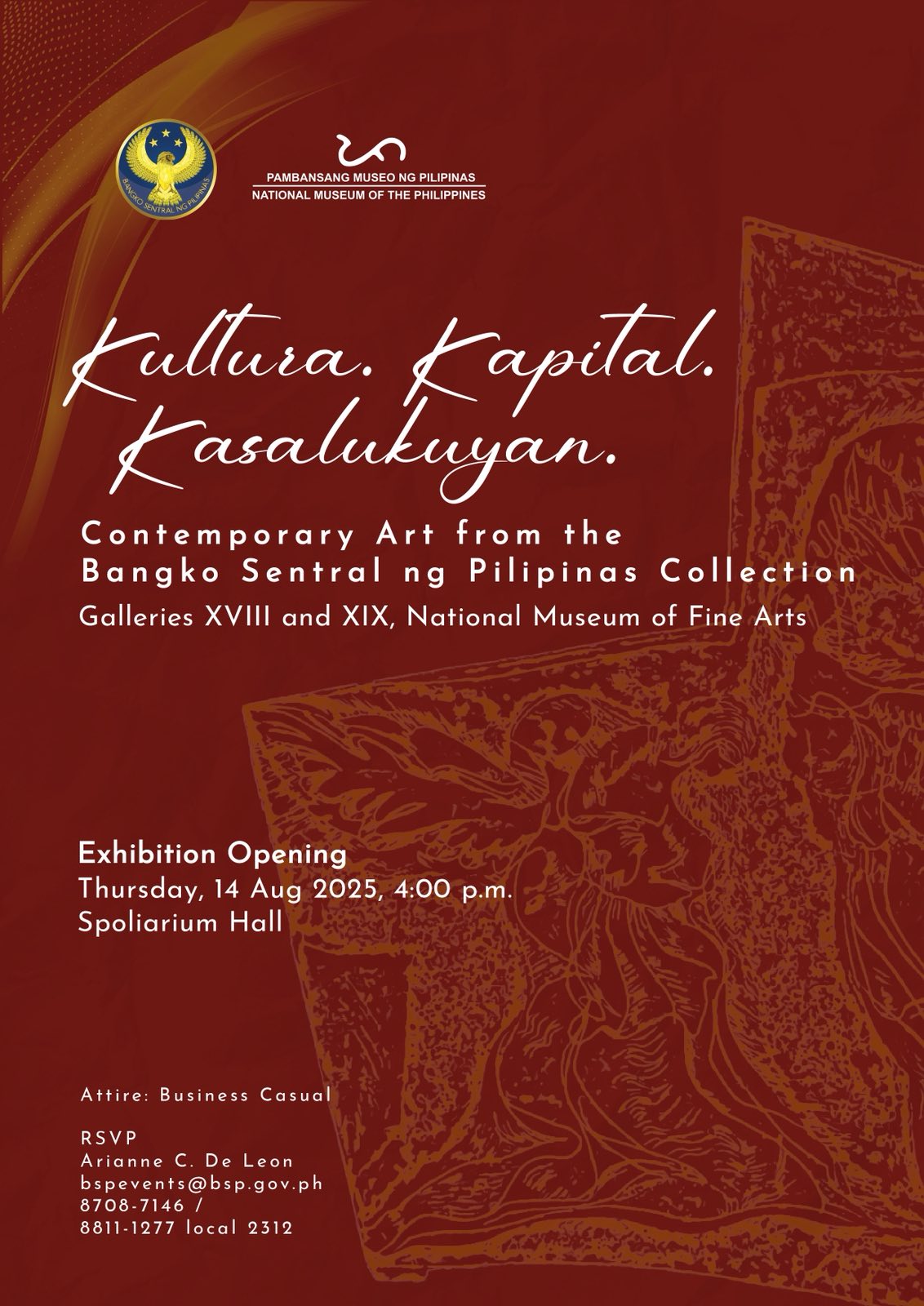
by Jose Carlos G. Campos, Board of Trustees National Museum of the Philippines
The National Museum of the Philippines (NMP) and the Bangko Sentral ng Pilipinas (BSP) recently teamed up to prove that money isn’t just for counting—it’s also for curating! Their latest joint exhibition, Kultura. Kapital. Kasalukuyan: Contemporary Art from the Bangko Sentral ng Pilipinas Collection, is now open, and it’s a real treat for art lovers and culture buffs alike.
On display are gems from the BSP’s contemporary art collection, including masterpieces by National Artist Benedicto Cabrera (Bencab), along with works by Onib Olmedo, Brenda Fajardo, Antipas Delotavo, Edgar Talusan Fernandez, and many more. Some of the artists even showed up in person—Charlie Co, Junyee, Imelda Cajipe-Endaya, Demi Padua, Joey Cobcobo, Leonard Aguinaldo, Gerardo Tan, Melvin Culaba—while others sent their family representatives, like Mayumi Habulan and Jeudi Garibay. Talk about art running in the family!
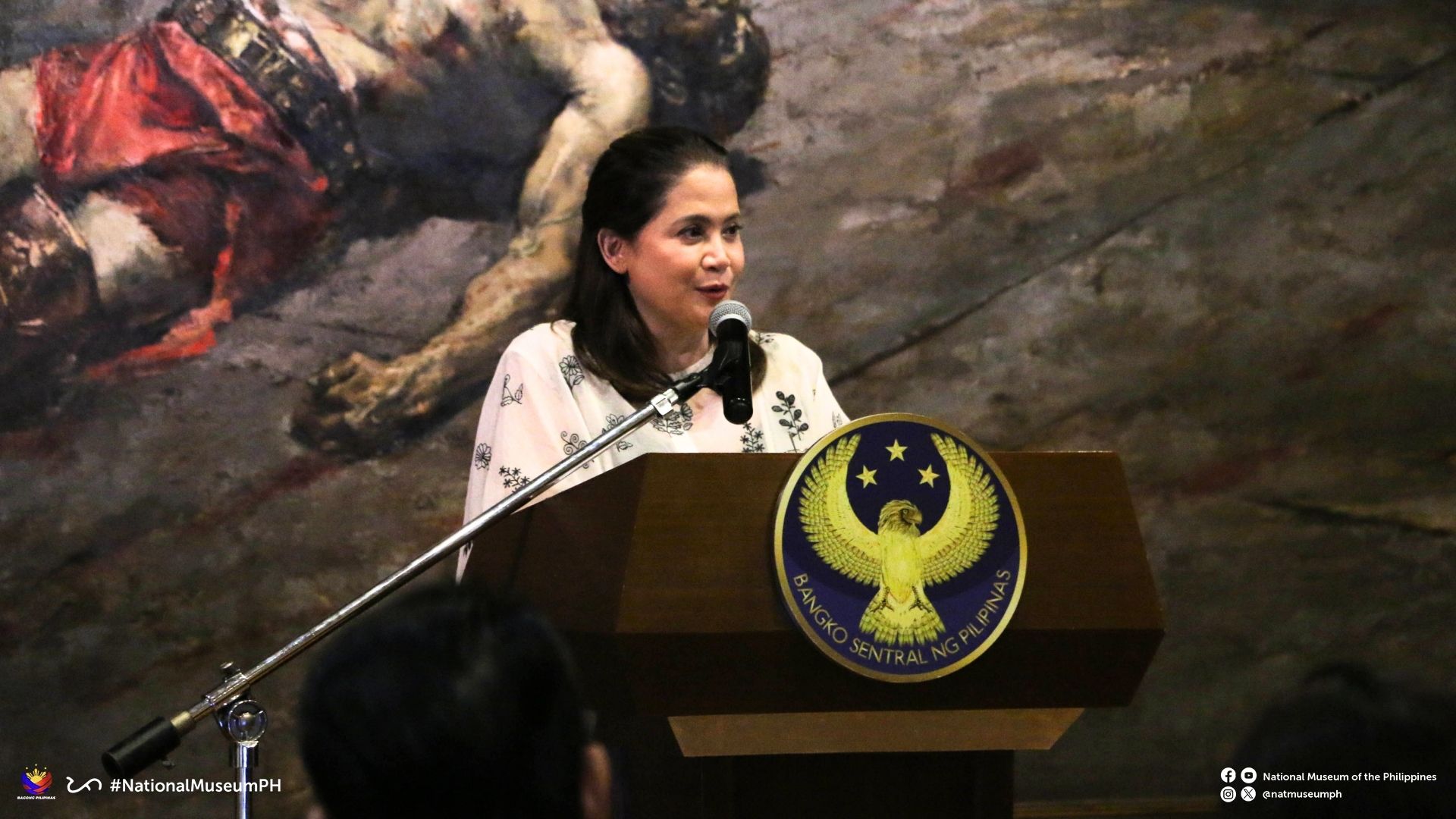
Deputy Governor General of the BSP, Berna Romulo Puyat
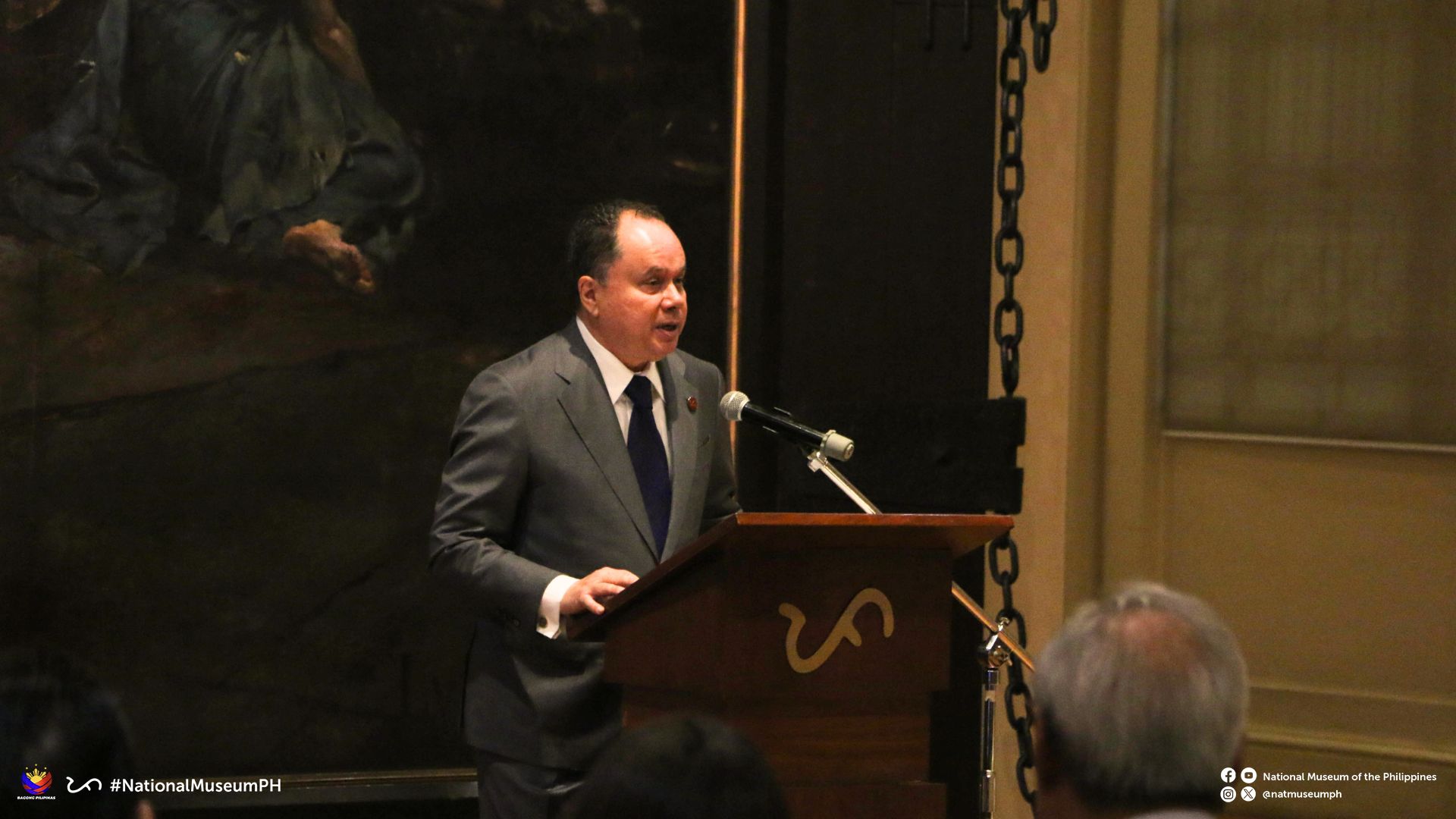
Chairman of NMP, Andoni Aboitiz
The BSP Governor Eli M. Remolona, Jr. and members of the Monetary Board joined the event, alongside former BSP Governor Amando M. Tetangco, Jr., Ms. Tess Espenilla (wife of the late Nestor A. Espenilla, Jr.), and the ever-graceful former Central Bank Governor Jaime C. Laya, who gave a short but enlightening talk about the BSP art collection.
From the NMP, Chairman Andoni Aboitiz, Director-General Jeremy Barns, and fellow trustees NCCA Chairman Victorino Mapa Manalo, Carlo Ebeo, and Jose Carlos Garcia-Campos also graced the occasion. Chairman Aboitiz expressed gratitude to the BSP for renewing its partnership, calling the exhibition a shining example of how financial institutions can also enrich our cultural wealth.
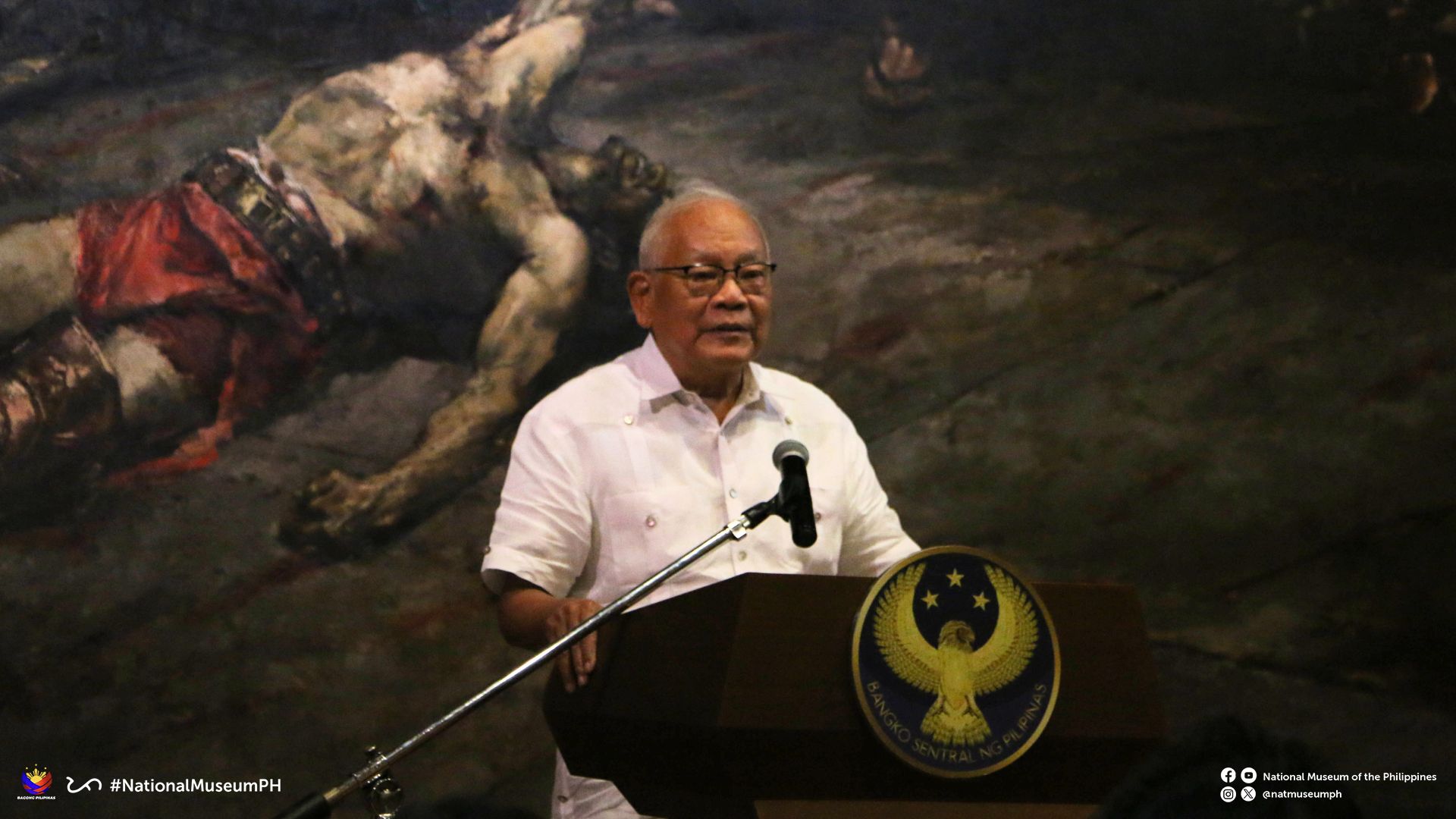
Former Governor of BSP Jaime Laya

Governor of BSP Eli M. Remona and Chairman of NMP Board Andoni Aboitiz
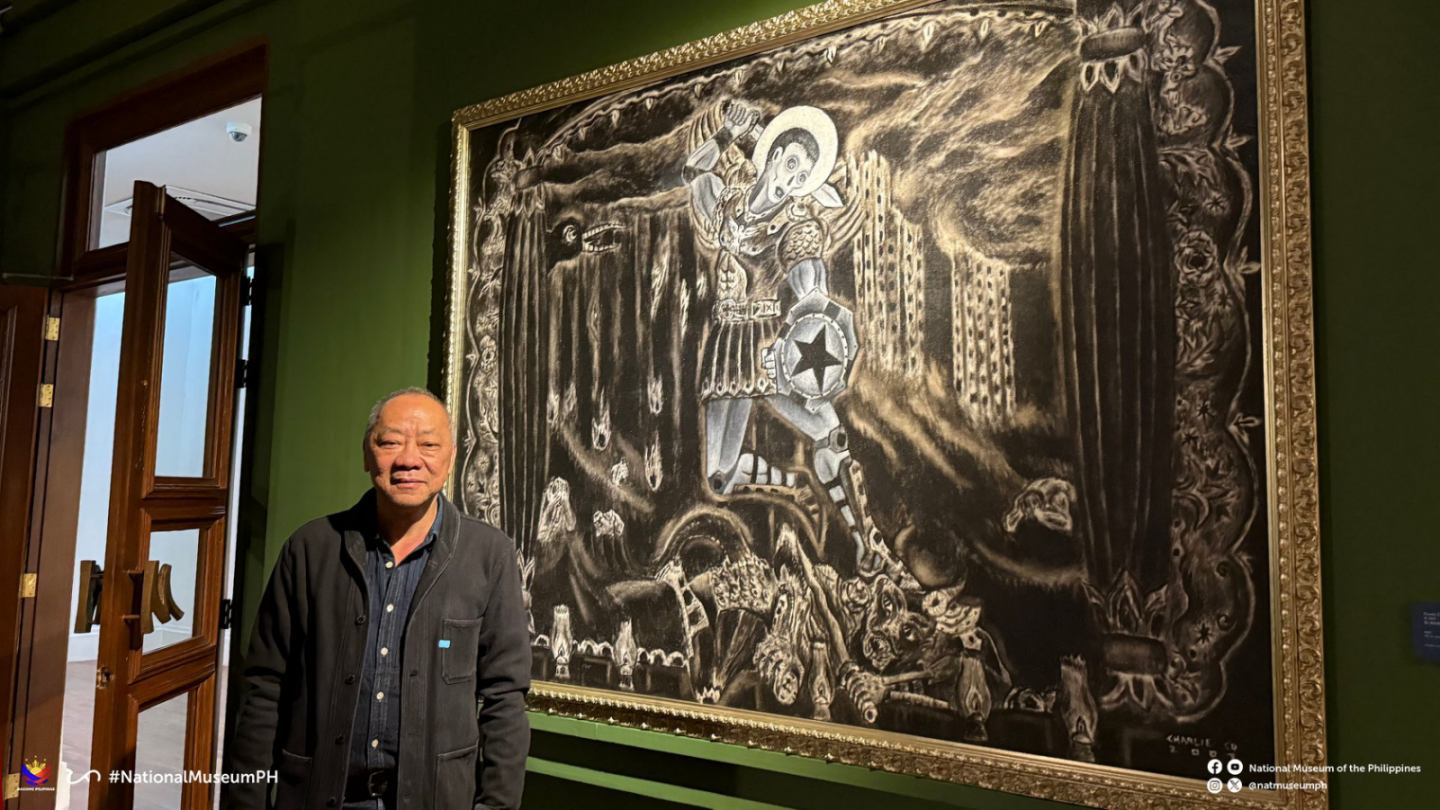
Artist Charlie Co
Before the official launch, a special media preview was held on 5 August, hosted by BSP Deputy Governor Bernadette Romulo-Puyat and DG Jeremy Barns. It gave lucky guests a sneak peek at the collection—because sometimes, even art likes to play “hard to get.”
The exhibition Kultura. Kapital. Kasalukuyan will run until November 2027 at Galleries XVIII and XIX, 3/F, National Museum of Fine Arts. Doors are open daily, 9:00 AM to 6:00 PM. So if you’re looking for something enriching that won’t hurt your wallet (admission is free!), this is your sign to visit. After all, the best kind of interest is cultural interest.
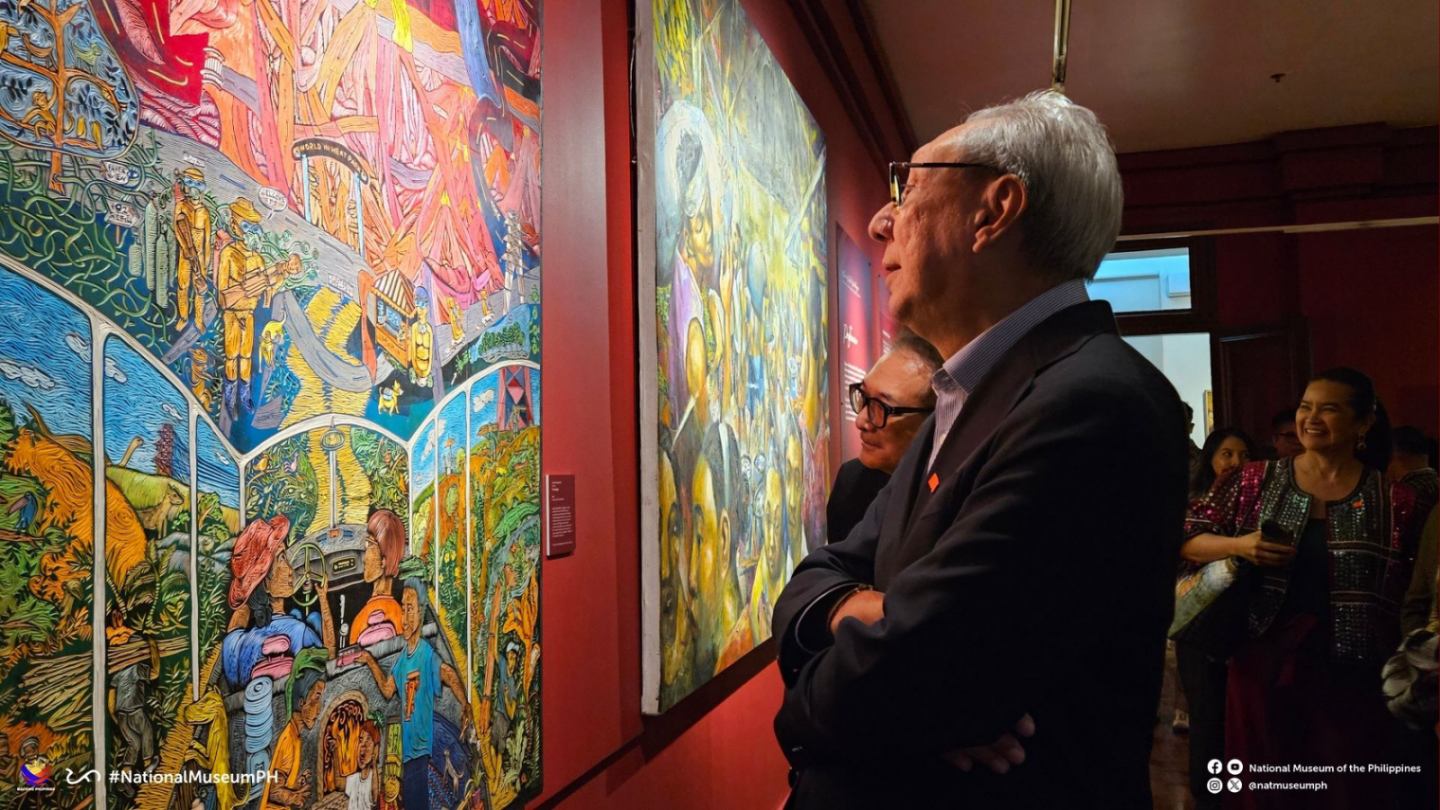
Monetary Board of the BSP, Walter C. Wassmer
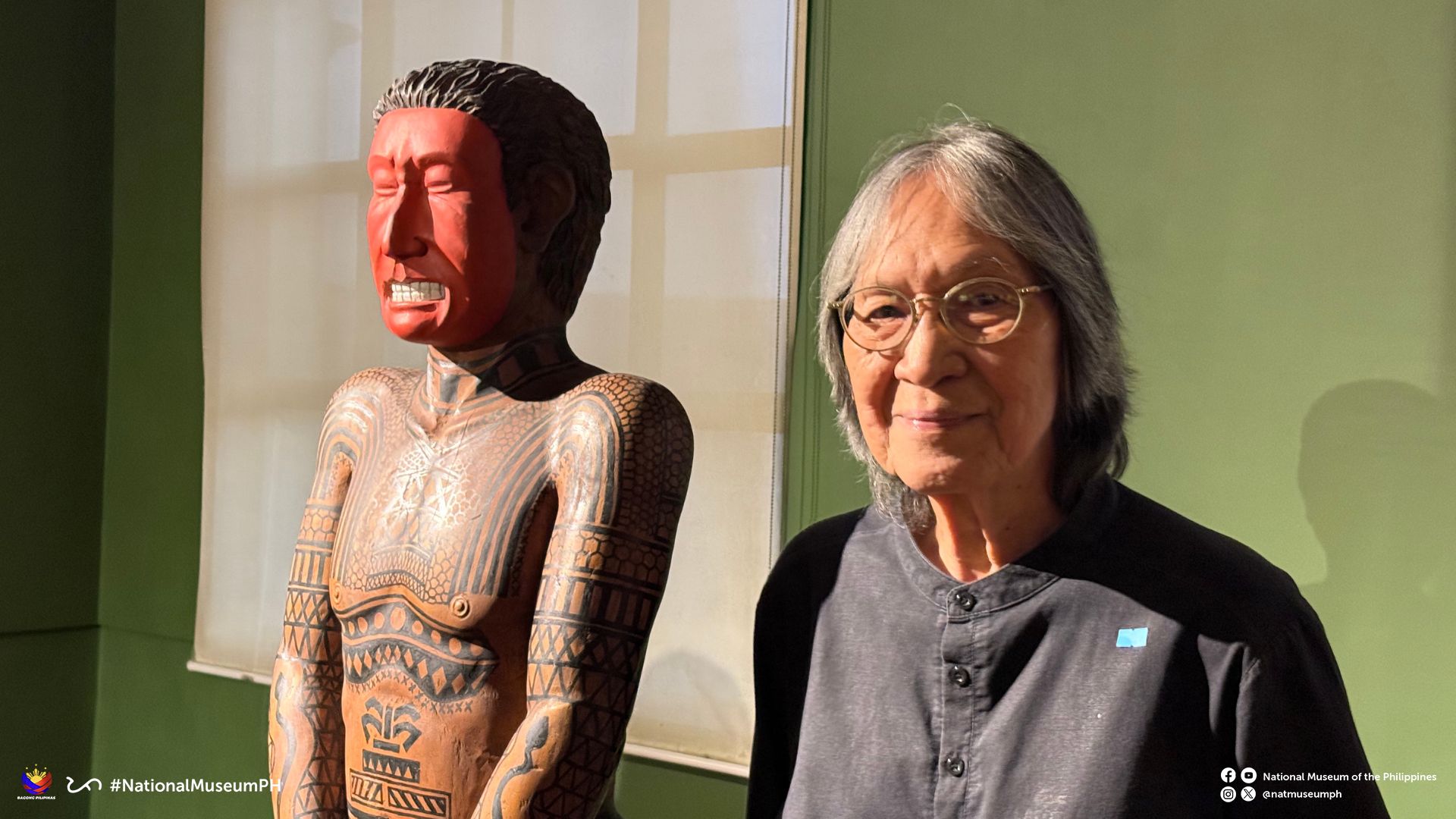
Luis Yee, Jr. aka ‘Junyee’ The Artist beside his Sculpture
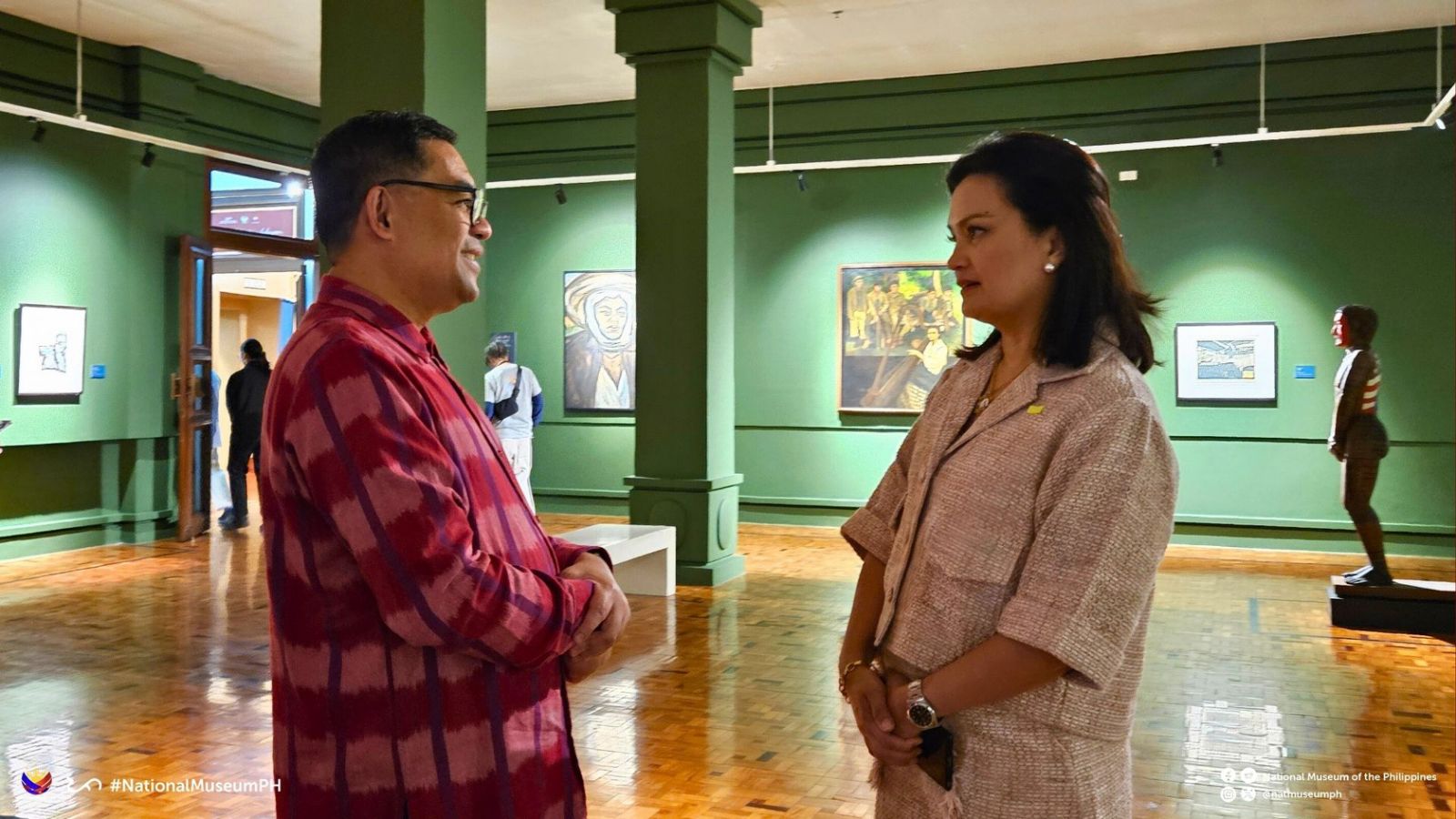
Arvin Manuel Villalon, Acting Deputy Director General for Museums, NMP with Ms. Daphne Osena Paez
Arts & Culture
Asia’s Fashion Czar I Knew as Tito Pitoy; Remembrance of a Friendship Beyond Fashion with Designer Jose R. Moreno
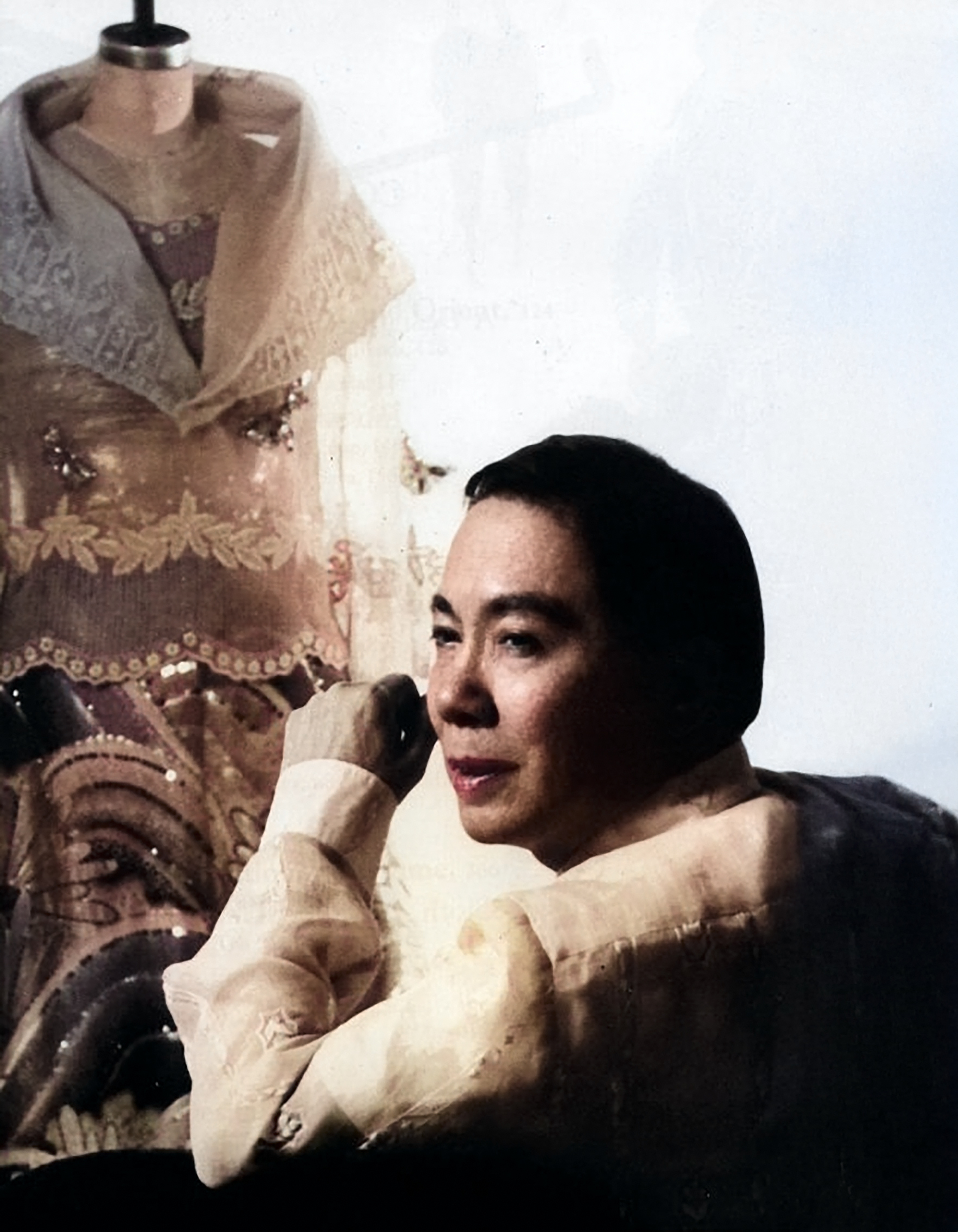
by Jose Carlos G. Campos, Board of Trustees National Museum of the Philippines
My childhood encounter with the famous Pitoy Moreno happened when I was eight years old. My maternal grandmother, Leonila D. Garcia, the former First Lady of the Philippines, and my mother, Linda G. Campos, along with my Dimataga aunts, brought me to his legendary atelier on General Malvar Street in Malate, Manila. These were the unhurried years of the 1970s.
As we approached the atelier, I was enchanted by its fine appointments. The cerulean blue and canary yellow striped canopies shaded tall bay windows draped in fine lace—no signage needed, the designer’s elegance spoke for itself. Inside, we were led to a hallway adorned with Art Deco wooden filigree, and there was Pitoy Moreno himself waiting with open arms—”Kamusta na, Inday and Baby Linda,” as he fondly called Lola and Mommy.
“Ahhh Pitoy, it’s been a while,” Lola spoke with joy.
“Oh eto, may kasal na naman,” my mom teasingly smiled.
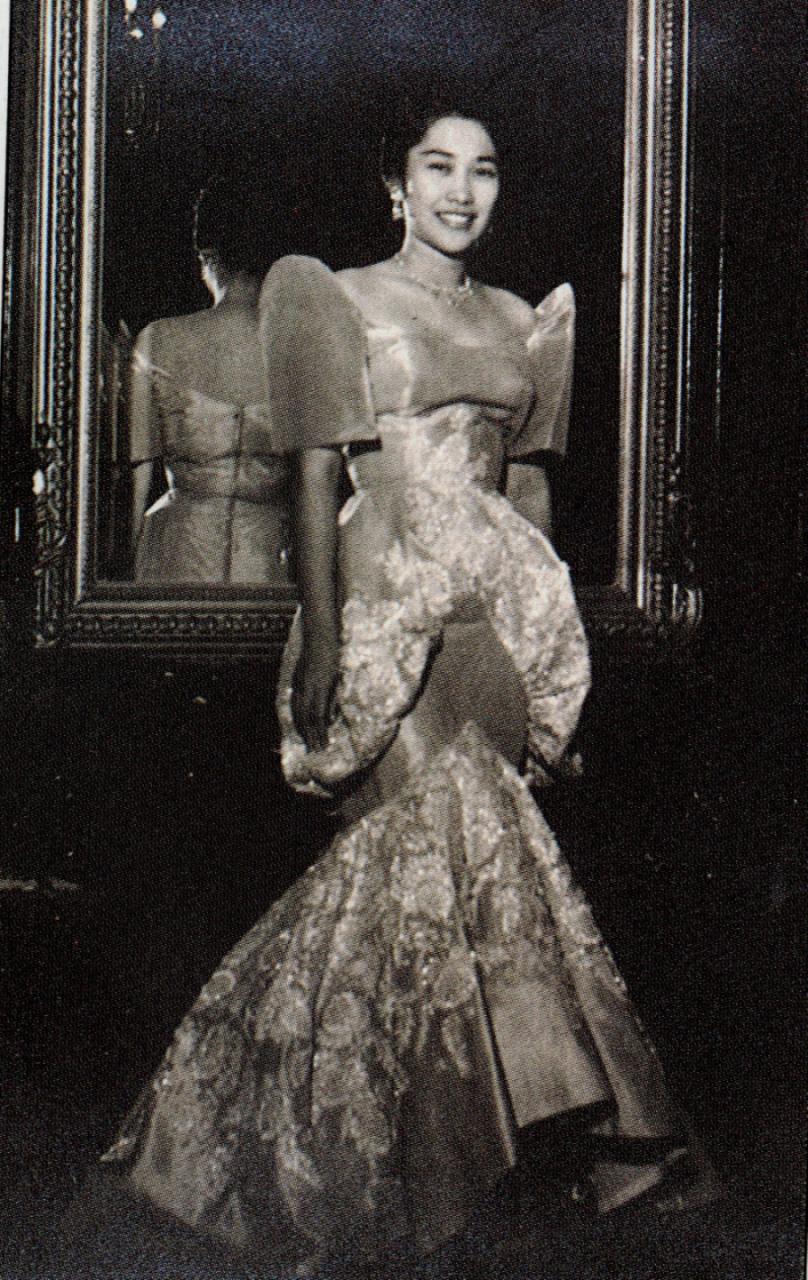
Linda Garcia Campos and Pitoy Moreno’s friendship started when they were students in the University of the Philippines in Diliman.
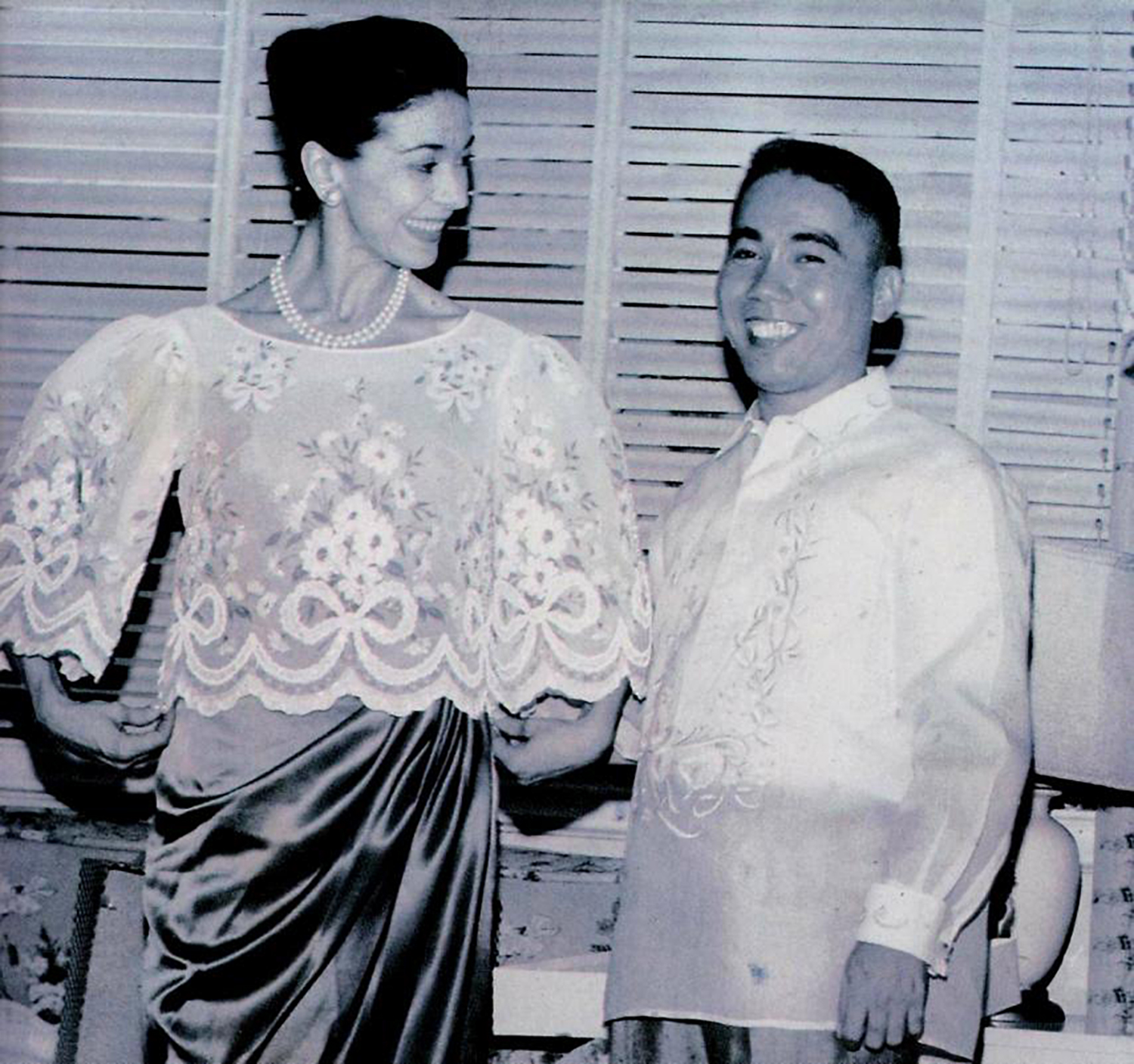
When Dame Margot Fonteyn came for a visit to Manila, Pitoy Moreno dressed her up for an occasion.
We had entered a world of beauty—porcelain figurines, ancient earthenware and pre-colonial relics. It was like stepping into a looking glass, only Pitoy could have imagined.
Destiny led me back years later when my mother Linda told me that Pitoy Moreno was working on his second book, Philippine Costume, and needed research material and editorial advice. At this point, around the 1990s, I was in between assignments—unsure of how a broadcasting graduate like me could possibly contribute to a fashion icon’s masterpiece. Fortunately, I agreed to the project.
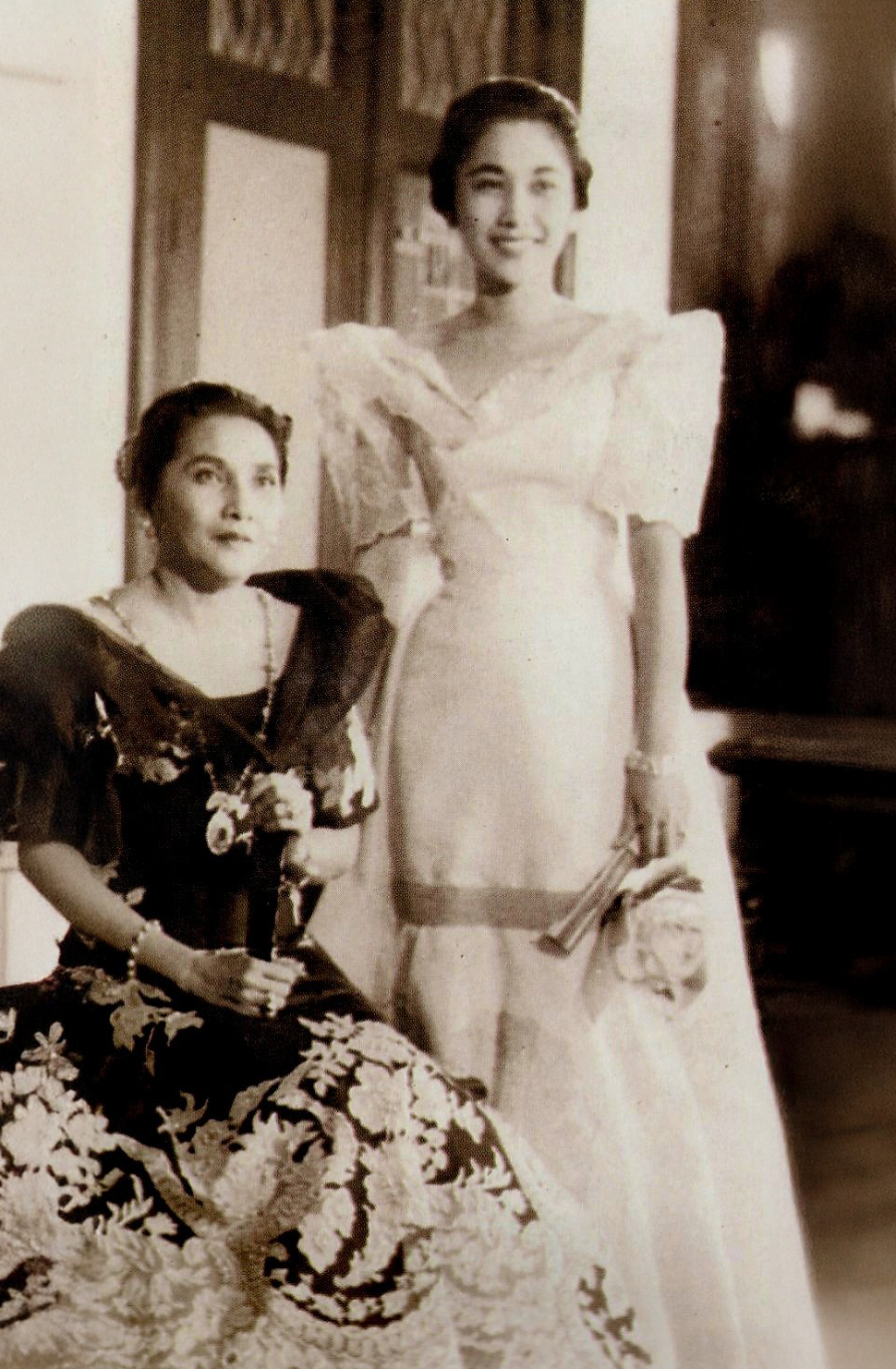
Former First Lady Leonila D. Garcia and daughter Linda G. Campos in Malacañang Palace.
Returning to the designer’s atelier brought back a rush of pleasant memories. The gate opened, and there stood Pitoy Moreno, beaming as always.
“Come in, hijo. Let me show you what I have in mind—and call me Tito Pitoy, okay?”
He led me to his worktable.
“I want to publish a book that tells the story of Philippine fashion—from our pre-colonial roots to the present. A designer’s collection of images and heritage expressed in clothing.”
I was awestruck. “How can I help you?” I inquired.
“Did you know that your mother, Linda, was my barkada in the University of the Philippines in Diliman?” he grinned.
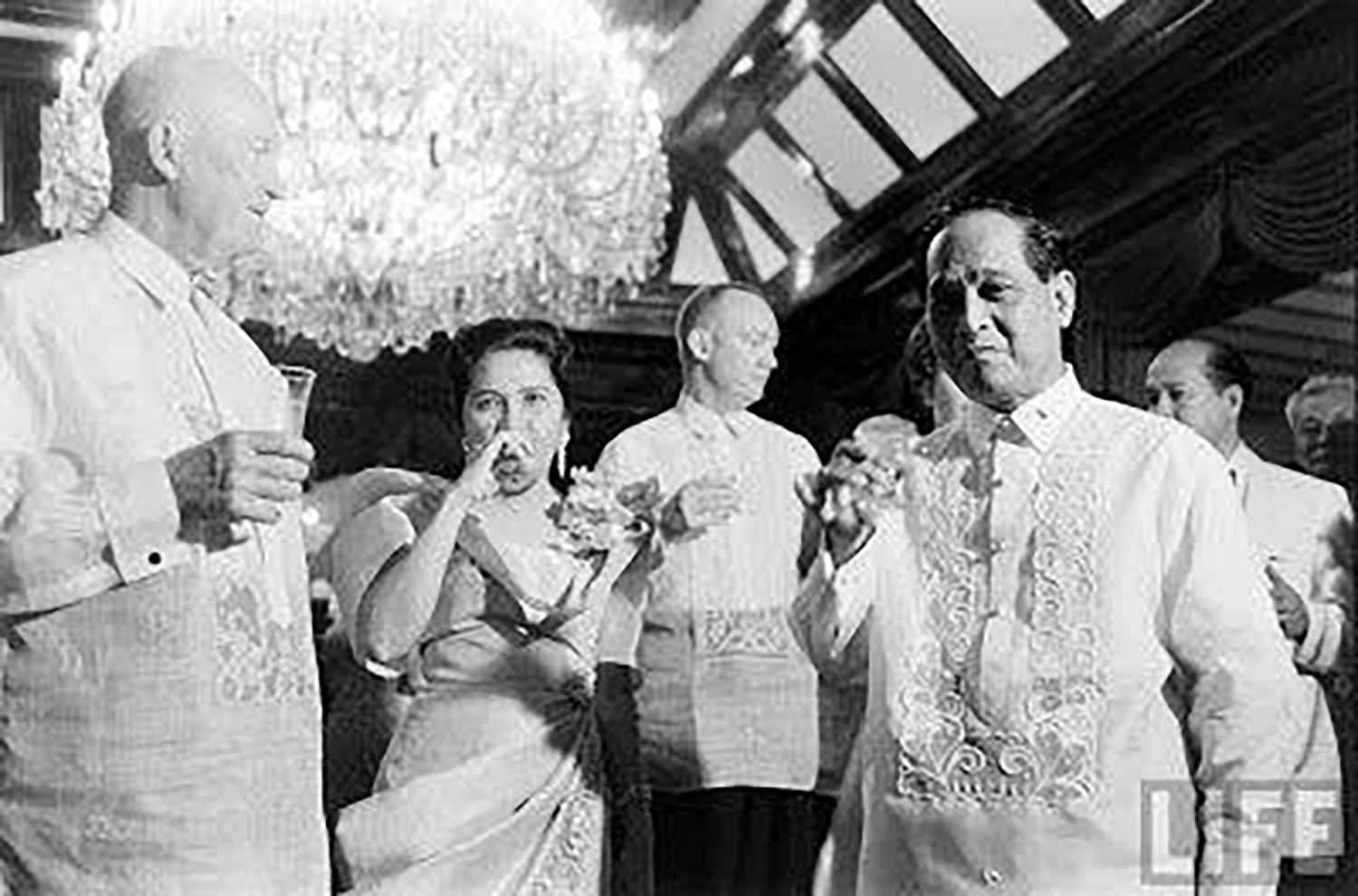
US President Dwight Eisenhower with First Lady Leonila Garcia and President Carlos Garcia in a state dinner at Malacañang Palace in Manila.
That friendship soon led to one of the proudest moments of the designer’s life. He had the opportunity to dress not only the First Lady Leonila D. Garcia but also President Carlos P. Garcia during his term. It was also during this time that the President of the United States, Dwight Eisenhower, came for an official visit to Manila. The designer was able to make clothes for the President, his daughter, and his staff.
“Eisenhower even asked for discounts on the barong Tagalog,” Tito Pitoy laughed.
Tito Pitoy then asked if I could find a terno he had made for my Lola, the former First Lady, which she wore for President Eisenhower’s state visit in 1960.
“How about her other ternos, dated from the 1920s to the 1960s?” I offered.
He lit up.
I scoured my Lola’s extensive closet—it felt like unearthing a legacy. Tucked behind layers of vintage ternos from countless fashion designers, I found that terno, which was photographed by Dick Baldovino along with other pieces for the book project. Once the project was finished and I myself had moved on, my bond with Tito Pitoy never wavered.
When my Lola passed away, he was deeply touched when I personally informed him of the sad news. Once, at the wake of former Vice President Salvador Laurel, he asked me to assist him in the placement of the medals in the chapel.

Philippine Costume by Jose Moreno is the designer’s collection of images and heritage expressed in clothing.
Tito Pitoy later invited me to his 80th birthday celebration—a dazzling Manila affair in 2012. During the evening’s festivities, he handed me a printed copy of Philippine Costume and added warmly,
“Thank you, hijo. I’ll call on you for the next one.”
The highlight of his career—and his most unforgettable moment—came during the Metro Magazine Gala fashion show: A Tribute to Pitoy Moreno, Fashion Icon. A collection of evening gowns spanning six decades—many of them unseen and tucked away in his atelier—were revealed that night. When the finale came, Tito Pitoy walked the stage, triumphant and waving to a sea of admirers. Longtime friends from the industry, society’s finest, and fashionistas rose from their seats and gave him a standing ovation.
It wasn’t just to celebrate his craft and ingenuity—it was to honor the man who brought elegance, history, and heart in every stitch.
-
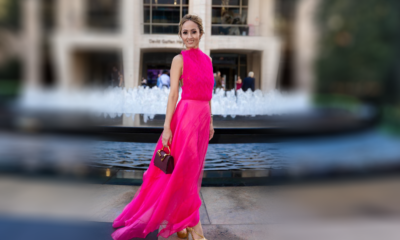
 Style1 month ago
Style1 month agoHappy Melendres Traipsing Around Manhattan in Non-Stop Armani
-

 Style3 months ago
Style3 months agoThe Invisible Part of Fashion: Five of the Most Enduring Fragrances of All Times
-

 Arts & Culture2 months ago
Arts & Culture2 months agoKultura. Kapital. Kasalukuyan: Art that Speaks of Today
-

 Prime Target4 weeks ago
Prime Target4 weeks agoMiko Sarmiento: Turning Silk Scarves Into Works of Art
-

 The Scene2 months ago
The Scene2 months agoAnother Elegant Dinner at Chez Marguerite
-

 Prime Target2 months ago
Prime Target2 months agoLuna Vdl–Endless Summers in Siargao
-

 Arts & Culture1 week ago
Arts & Culture1 week agoVisayas Art Fair Year 5: Infinite Perspectives, Unbound Creativity
-

 The Scene2 months ago
The Scene2 months agoA Stylish Soirée: Cebu’s Elite Celebrate Jackie Deen Lotzoff at Mad Thai








